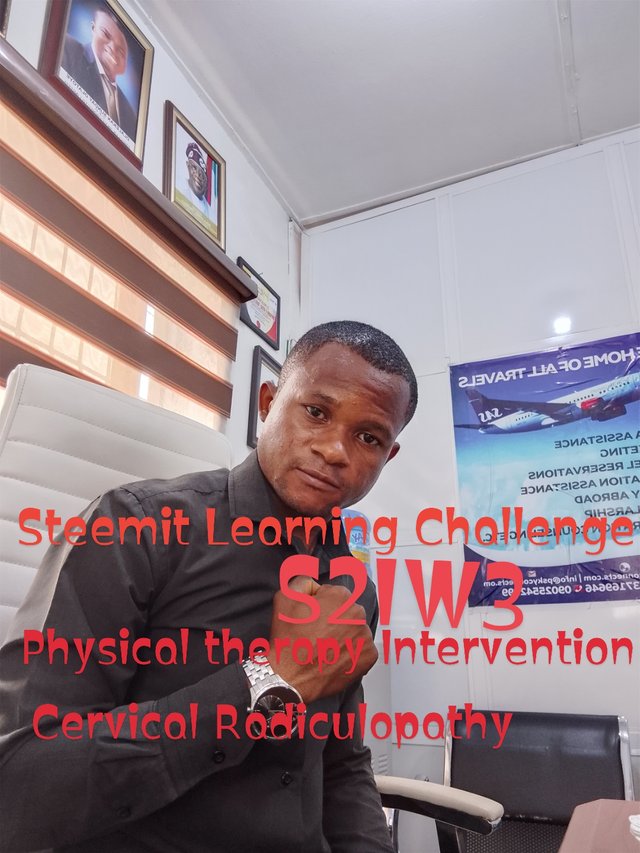Steemit Learning Challenge-S21W3; Cervical Radiculopathy

- 1. What's Cervical Radiculopathy? Write in your own words after getting knowledge from the lesson post.
It's often referred to as a "pinched nerve," cervical radiculopathy happens when a nerve in the neck (cervical spine) becomes compressed or inflamed where it emerges from the spinal cord. The shoulder, arm, or hand may experience pain as a result of this compression, frequently accompanied by tingling, numbness, or weakness in those muscles. Herniated discs, degenerative disc disease, arthritis, and injuries are among the causes. Physical examinations, imaging tests (such as CT or MRI scans), and occasionally nerve conduction investigations are used to make the diagnosis. Physical therapy, drugs, injections, and, in extreme situations, surgery are all possible forms of treatment.
- 2. How would you diagnose a Cervical Radiculopathy? Any clinical investigation or assessment tests?
Cervical radiculopathy is often diagnosed using a combination of imaging, functional testing, and clinical evaluation. This is a common method:
Clinical Assessment -Medical History and Symptoms: Compiling information regarding arm-to-neck pain, tingling, numbness, or muscle weakness.Tests for reflexes, muscle strength, and changes in hand or arm sensation are part of the physical examination.
Specialised Tests - Spurling's Test: The doctor angles the neck towards the uncomfortable side while applying little pressure to the top of the head. Irritation of the nerve roots is indicated by pain.Neck Distraction Test: If nerve root compression is present, applying mild traction to the head may alleviate symptoms.
Neure testing and imaging - MRI: Identifies soft tissue problems like as inflammation or herniated discs.CT or X-ray: Showcases degenerative alterations or anomalies in the bones.
Electromyography (EMG) and Nerve Conduction Studies: In order to determine which nerve root is impacted and the precise cause of radiculopathy, treatment options are guided by the results of electromyography (EMG) and nerve conduction studies, which measure electrical activity to indicate nerve compression or injury.3. Try to practice at least 3 exercises that you have learned from the lesson. Share images, gifs or videos while practising.
https://youtube.com/shorts/OjfAVsNKGdo?si=AxJrA6mHSMhaI3Ys
https://youtube.com/shorts/TWwNiV7PBg0?si=y3ST1g8gD4Oxud6X
https://youtube.com/shorts/HIHpXAIgCTo?si=tmCvDS3W83oTv876
https://youtube.com/shorts/2xFD3U0RVn8?si=1zNH0dXNP0ox-qe7
https://youtube.com/shorts/RRo_FvAkKtc?si=JvYsl4ztRKDynsPq
- 4. Share your review after performing these exercises either on yourself, healthy individual or patient.
Here's a more detailed review of each exercise based on my experience:
Isometric Cervical Rotation: This low-impact but efficient exercise is excellent for strengthening the neck muscles involved in rotation without any actual movement. It safely increases strength by gently resisting either side's head rotation. It is particularly helpful for improving neck stability, which is advantageous for those who have neck pain or restricted movement as a result of an accident.
Isometric Neck Extension and it works the muscles in the back of the neck that hold the head up straight. These muscles are gradually strengthened by pressing the back of the head against resistance (such as your hands or a wall) while remaining still. Because it helps counterbalance the affects of forward head posture that many individuals get from sitting at desks or gazing down at phones, I found this exercise to be beneficial for improving posture.
Isometric Neck Retraction: By using the deep stabilising muscles, which promote good head posture and lessen spinal strain, this exercise helps to improve neck alignment. It helps to counteract the tendency to lean forward by training your neck to stay aligned by gently pressing the back of the head into your hands while tucking the chin.
Stretching the trapezius, scalene, and levator scapulae: This set of stretches helps release tension in the shoulders, upper back, and neck. The upper neck and shoulder muscles, which can retain a lot of stress, can be released by stretching the levator scapulae and trapezius. Range of motion can be enhanced by stretching the scalenes on the sides of the neck. When combined, these stretches aid in reducing pain from everyday stressors and extended sitting.
Upper Trapezius Stretch: This stretch focuses on releasing tension primarily in the upper trapezius, which commonly tightens from stress or poor posture. It entails tilting the head to one side while gently pulling with the other hand. This is a soothing and helpful addition, especially if you carry stress in your upper back, as I found it to be exceptionally excellent in easing tension and increasing shoulder and neck flexibility.
All things considered, these stretches and exercises successfully ease and strengthen the upper back, shoulders, and neck, promoting flexibility, stability, and good posture. They're an excellent approach to promote neck health and improve comfort levels all day long.
Hello @ashkhan
Hey @olawalium @tojukaka @harbysco @mammasita you can participate!!??
https://x.com/opeyemioguns3/status/1855952211349487810?t=PyHKsyyyyuJZ2Yvx-rn-OQ&s=19
Thank you for understanding the lesson and sharing your assignment; I hope that you will enjoy this week's lesson and try to implement it in your life if you see any such case.
Observations
Task 1 (2.8/3)
You have shared a good knowledge about cervical radiculopathy, and it's cause, symptoms, treatment but you have to add the vertebrae that are mainly involve in cervical radiculopathy. I bit more depth require to complete the answer. I appreciate your effort.
Task 2 (2.9/3)
In the second question, you tell us about how you have to assess a patient by doing the physical examination, history taking, investigations of patients and specialized tests. You have share good knowledge but the main test for nerve examination is NCS nerve conduction test then EMG. Great.
Task 3 (3/4)
You try the isometric neck rotation, retraction, extension and upper Trapezoius stretch. But while performing these exercises you have to apply resistance with head to hand not simply place hand on head. Stretch should be applied for 5 to 10 seconds for effectiveness. Remember always apply heating pad to relax your muscles before performing these exercises. I appreciate your efforts.
Overall you made a good attempt to answer all the questions. I appreciate your efforts. But next time try to avoid the above written suggestions. Keep learning and try to implement your knowledge to the people suffering from any cervical radiculopathy. Thank you.